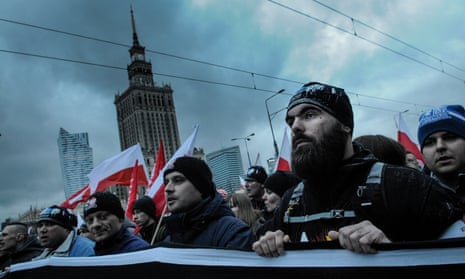My friend was late for Sunday brunch in Berlin so I decided to wander the streets of Neukölln, Googling sites of historic interest. After a few minutes, I wished I hadn’t. Although 40% of its population are migrants, mainly from Turkey, Neukölln is gentrifying fast: the cobbled streets bordering the old Tempelhof airfield are buzzing with upmarket cafes, interior-design stores and the retro bicycles of the middle class.
But this is the place where, on 11 November 1926 Josef Goebbels began the Nazi takeover of Berlin. As a gesture of intent, he led 300 of the party’s brownshirt stormtroopers into what was then a stronghold of the left: “Four seriously injured, four slightly hurt, but we’re on the march,” recorded the future war criminal in his diary.
Today, Neukölln is Berlin’s main venue for Nazi attacks – this time anonymous. Out of 45 recorded cases of racist violence in Berlin this year, 35 took place in Neukölln. They involve arson, swastika graffiti, bricks through shop windows and threatening notes sent to migrant shopkeepers. There have been neo-Nazis around this district for years, but, according to the Mobile Counsel Against Rightwing Extremism, an anti-fascist monitoring group, the attacks have changed – from the torching of the cars of leftwing politicians to the targeting of migrants and the NGOs helping them. The attackers originally operated in a Facebook group, but it was taken down after it published a Berlin-wide map of Jewish institutions.
Amid the mix of halal meat stores and veggie cafes, I don’t sense tension: there is strong community organisation here, supported by the city’s left-led government – almost every lamp-post has an antifa sticker on it and there’s a liberal, multicultural vibe. But what’s happening here dramatises the dangers facing Europe.
In Poland this weekend neo-Nazis staged a march that drew 60,000 people on to the streets to celebrate the country’s independence day, chanting: “Refugees out!” and carrying banners, some with racist slogans. The interior minister, Mariusz Błaszczak, called the march a “beautiful sight”; the pro-government TV news called it “a great march of patriots”. Tommy Robinson, the British far-right campaigner, tweeted that he had “an amazing trip to Poland and was shown great hospitality”, adding: “Poland is fortress Europe.”
The Italian far-right group Forza Nuova, whose leader was also at the Polish march, staged a smaller demo in Rome last week, while in the unionist agitation against Catalan independence in Spain, Francoist flags and salutes have been repeatedly spotted.
After the victory of Emmanuel Macron, and the failure of the far-right PVV to break through in the Netherlands, European centrism had been congratulating itself on stemming the tide. The massive vote for the far-right FPO in Austria, and its potential entry into a coalition government, cast a dark shadow over the political mainstream, and Saturday’s march in Warsaw will do the same.
This is happening when Europe’s economy is growing faster than at any time since the 2008 crisis. Poland’s unemployment rate is 5.3%, a record low. In the late 1920s, fascism was driven by economic desperation. In Poland, it is being driven by a white, Christian supremacist ideology that political and social elites seem unwilling to challenge. Its core message is: no more social change.
The assumption in the political mainstream is that if you police the borders demonstratively, acknowledge people’s fears about integration, maintain economic growth and throw development aid at north Africa, eventually the tensions driving neofascism will go away. But modern fascism is no longer a response to single events: it is – as the outpourings of people such as Tommy Robinson repeatedly remind us – about Islam and white identity. It is the headscarf, the mosque and the Qur’an that the fascists marching through Warsaw care about, not the economic strain brought about by refugees. Poland has dealt with a grand total of 1,474 asylum claims this year, just 18 of them from Syria; the rest mostly from white, Christian Russia and Ukraine.
I will not criticise those who try to stop fascists marching: it is a legitimate tactic given the danger. But the 2,000-strong antifa mobilisation in Warsaw – up against 60,000 people enjoying the moral support of the government and the media – suggests we are not going to stop them that way this time.
In the places where it was stopped, as in France in 1934, the left and the liberal centre achieved tactical unity and created a narrative of hope. Centre-left and leftwing governments in power delivered radical change; the fascist media was counteracted by a vibrant liberal media; the massive social power of the labour movements, the churches and the synagogues was mobilised.
This time around, the forces are different: labour movements are weaker and democratic constitutions stronger; the media is often in the hands of xenophobic billionaires, while many state TV stations are paralysed by or even complicit in the racist narrative. Probably the biggest difference is the high level of theory and consciousness you find in the online groups of the new far right. It is an international movement, fuelled by dollars and airtime both from the pro-Trump right and, in some cases, by Russian intelligence.
Its breakthrough moments will not take place through street fights, as in the 30s, but through symbiosis with sections of the mainstream, nationalist conservative right. And this is happening: in the Austrian coalition talks, in Poland, in Hungary and, of course, in the US, where the entire narrative of the pro-Trump news media feeds the paranoias of the far right.
The far right across Europe has challenged progressive politics to a death match. Anybody who thinks this is going away without a fight is displaying an irrational appetite for political risk.

